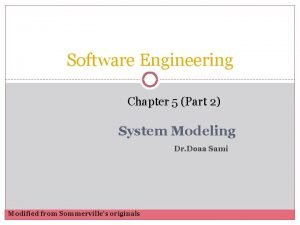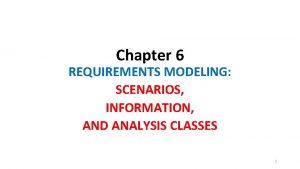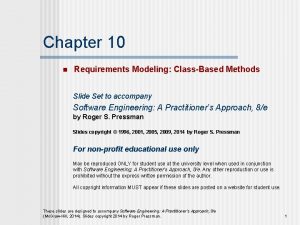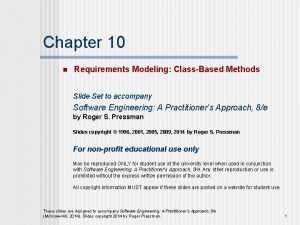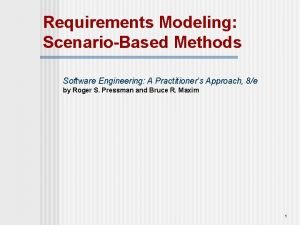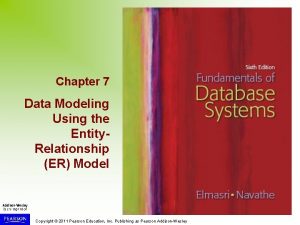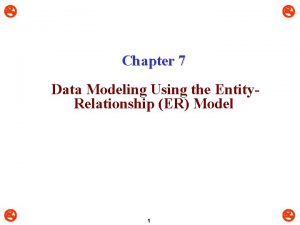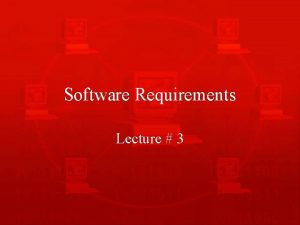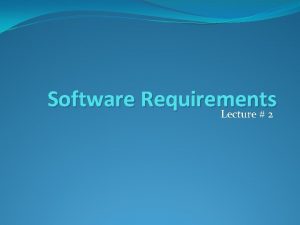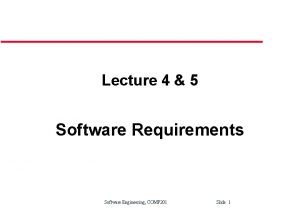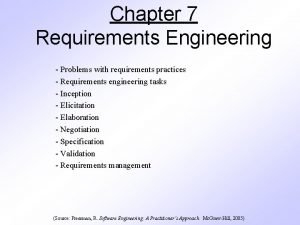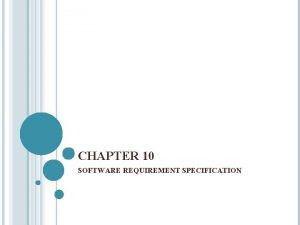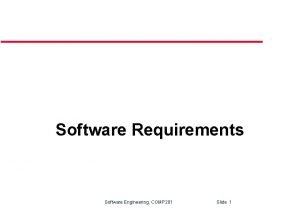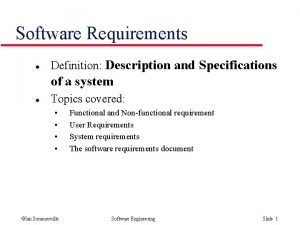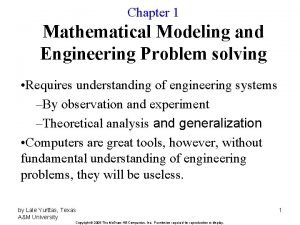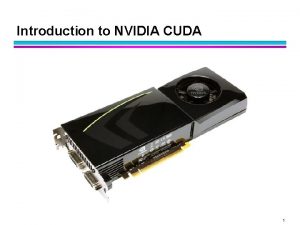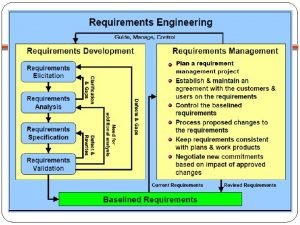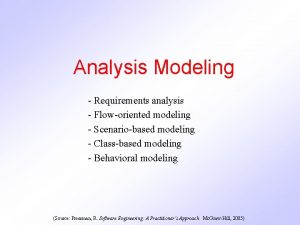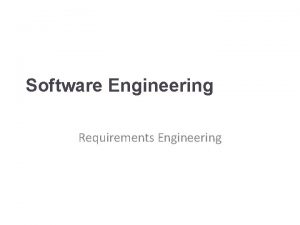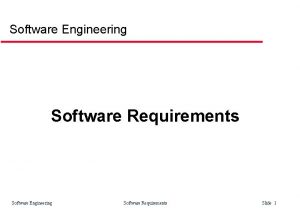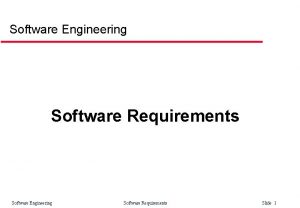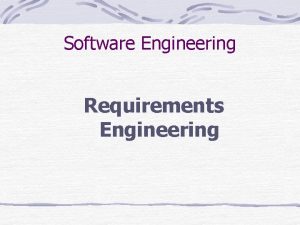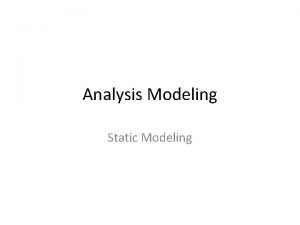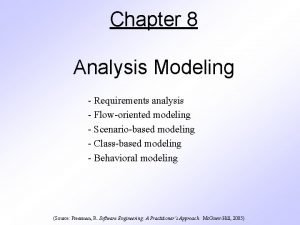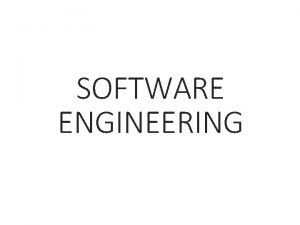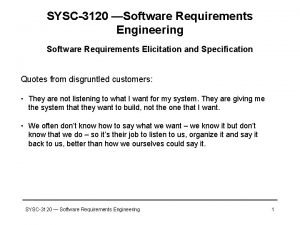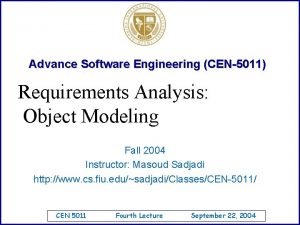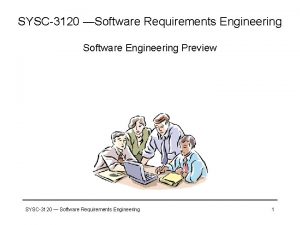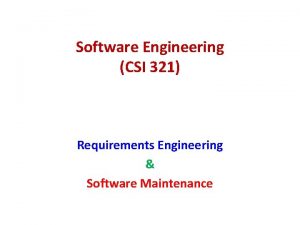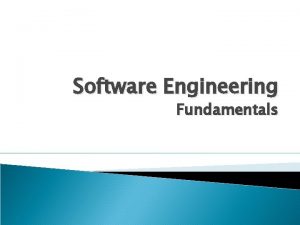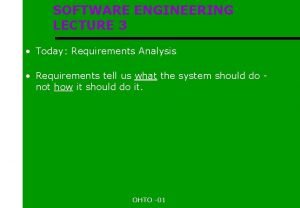Requirements Engineering Requirements Analysis Software Modeling Data Model





































- Slides: 37

Requirements Engineering

Requirements Analysis

Software Modeling Data Model �structure of the information, e. g. , ER diagram Function and Information Flow Model �what we will do with the data, e. g. , DFD, Use-Case Behavior Model �how we interact with the system, e. g. , State Transition Diagram

Data Flow Diagram (DFD)

Where do they fit in? �Analysis (What do we do? ) �Fact finding �Investigate business process and the current system �Modelling the current and required systems �Deliverables �Requirements specification �Logical models of the required system

Data Flow Diagrams (DFD) �DFDs describe the flow of data or information into and out of a system �what does the system do to the data? �A DFD is a graphic representation of the flow of data or information through a system 3

4 Main Elements �External Entity (Source/Sink) - people or organisations that send data into the system or receive data from the system �Process - models what happens to the data i. e. transforms incoming data into outgoing data �Data Store - represents permanent data that is used by the system �Data Flow - models the actual flow of the data between the other elements

Notation

Levelled DFDs �Even a small system could have many processes and data flows and DFD could be large and messy �use levelled DFDs - view system at different levels of detail �one overview and many progressively greater detailed views 4

Level 0 - Context Diagram �Models system as one process box which represents scope of the system �Identifies external entities and related inputs and outputs �Additional notation - system box Data Flow Out System Data Flow In External Entity

Level 1 – Overview Diagram �Gives overview of full system �Identifies major processes and data flows between them �Identifies data stores that are used by the major processes �Boundary of level 1 is the context diagram

Level 2 – Detailed Diagram �Level 1 process is expanded into more detail �Each process in level 1 is decomposed to show its constituent processes �Boundary of level 2 is the level 1 process


Rules for DFDs �Numbering �Labelling �Balancing

Numbering �On level 1 processes are numbered 1, 2, 3… �On level 2 processes are numbered x. 1, x. 2, x. 3… where x is the number of the parent level 1 process �Number is used to uniquely identify process not to represent any order of processing �Data store numbers usually D 1, D 2, D 3. . .

Labelling �Process label - short description of what the process does, e. g. , price order �Data flow label - noun representing the data flowing through it, e. g. , customer payment �Data store label - describes the type of data stored �Make labels as meaningful as possible

Balancing �any data flows entering or leaving a parent level must by equivalent to those on the child level �Data stores �data stores that are local to a process need not be included until the process is expanded �Data Flows �Allowed to combine several data flows from lower level diagrams at a higher level under one data flow to reduce clutter �Flows should be labelled except when data to or from a data store consists of all items in the data store





Rules for Using DFD Symbols YES A process to another process A process to an external entity A process to a data store An external entity to another external entity An external entity to a data store A data store to another data store NO

List the Errors of this DFD



Use Case Diagram

Use Case Diagram �Use Case diagram is used to identify system requirements �Identify actors (users) of the system �Comparable to Context Diagram of DFD

Use Case Diagram: Notation Actor represents stakeholder or user of the system Use Case is a function of the system “association” is the relation between actor and use case “extend” and “include” are relations between use cases

Extend & Include �Stereotype <<extend>> is used to specify that a use case is extending another use case �Usually, an extending use case is adding extra function to the extended use case �Stereotype <<include>> OR <<use>> is used to specify that a use case is including other use cases �Usually, an included use case is a common function which is shared by many other use cases

Use Case Description �Text describing the use case �Example �Use Case Name: �Actors: �Precondition: �Postcondition: �Stakeholder: �Description: �Scenario:

Use Case Diagram Example

Use Case Description Example Use Case Name: Withdraw Actors: Customer Precondition: Customer enters correct pin number Postcondition: Customer receives correct amount of cash Stakeholder: Customer, ATM, Bank Description: The withdrawal from customer’s account via ATM Scenario: Next Slide

Example Scenario 1. Customer enters the amount to withdraw 2. System checks if the amount is valid 2. 1 The amount is valid, go to 3 2. 2 The amount is invalid, go to 4 3. ATM displays transaction and give out cash, go to 5 4. ATM displays an error message, go to 5 5. End




 Ock
Ock What is domain model in software engineering
What is domain model in software engineering Scenario based modeling in software engineering
Scenario based modeling in software engineering What is class based modeling in software engineering
What is class based modeling in software engineering Class based modeling in software engineering
Class based modeling in software engineering Scenario-based modeling in software engineering
Scenario-based modeling in software engineering System requirements checklist output example
System requirements checklist output example Helen c. erickson
Helen c. erickson Relational vs dimensional data modeling
Relational vs dimensional data modeling Requirement analysis diagram
Requirement analysis diagram Requirement analysis model in software engineering
Requirement analysis model in software engineering Data flow model in software engineering
Data flow model in software engineering Best practices for data warehousing
Best practices for data warehousing Data modeling using entity relationship model
Data modeling using entity relationship model Company er diagram
Company er diagram Inverse requirements
Inverse requirements Inverse requirements in software engineering
Inverse requirements in software engineering High level requirements
High level requirements Requirements discovery techniques in software engineering
Requirements discovery techniques in software engineering Dfd symbols
Dfd symbols What is domain requirements in software engineering
What is domain requirements in software engineering Domain requirements
Domain requirements Problems of requirements in software engineering
Problems of requirements in software engineering Characteristics of srs in software engineering
Characteristics of srs in software engineering Software requirement and design
Software requirement and design Source and sink in software engineering
Source and sink in software engineering Domain requirements examples
Domain requirements examples What is system in software engineering
What is system in software engineering Forward engineering in software engineering
Forward engineering in software engineering Software maintenance process models ppt
Software maintenance process models ppt What is software implementation in software engineering
What is software implementation in software engineering Metrics computer science
Metrics computer science Software engineering crisis
Software engineering crisis Software metrics example
Software metrics example Real time software design in software engineering
Real time software design in software engineering Design principles in software engineering
Design principles in software engineering Mathematical modeling and engineering problem solving
Mathematical modeling and engineering problem solving Computational engineering and physical modeling
Computational engineering and physical modeling

